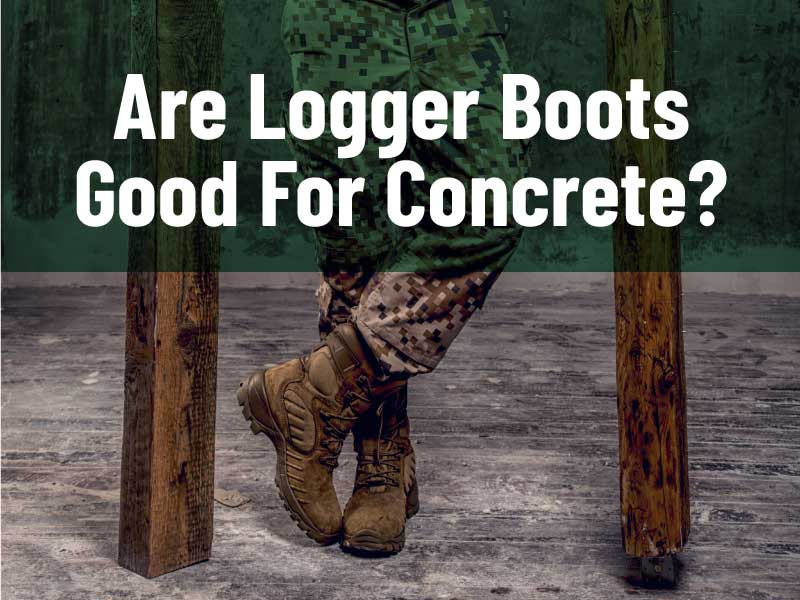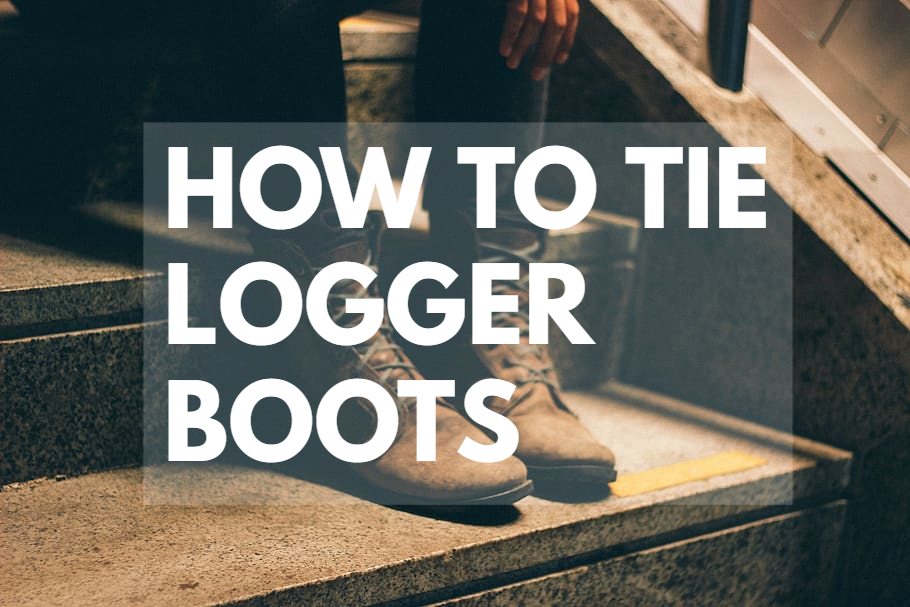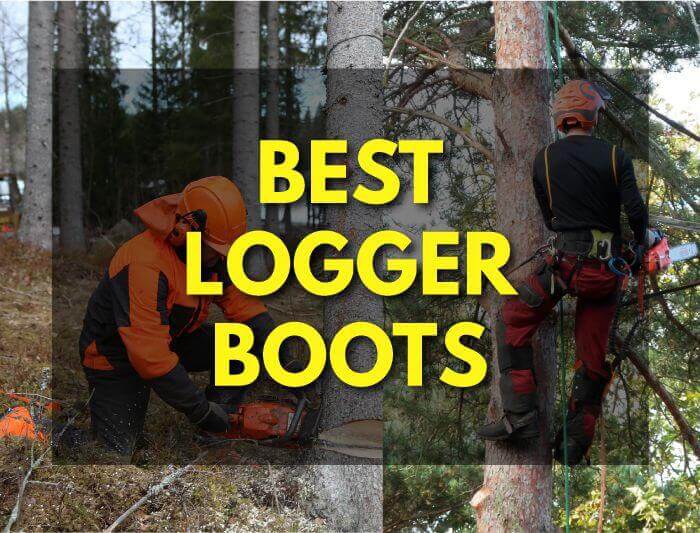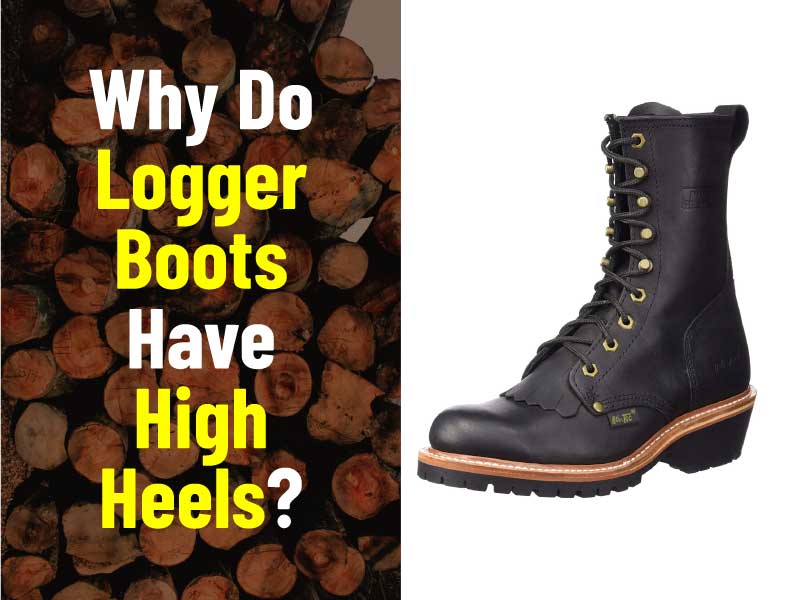Among the different types of boots we come across, logger boots are some of the most useful and reliable. When we say logger boots, we talk about a specific type of boots that loggers and lumberjacks use for their job. These boots are tough, and rigid, yet comfortable and fully waterproof, and provide very good support during any activity.
But the question is, are logger boots good for concrete? The answer is subjective. First of all, logger boots are created to handle the harshest of weather and terrain. All of that is to give you the best protection and comfort possible. That includes both hard and softer surfaces. As I know, concrete is supposed to be a hard surface, so many people consider wearing logger boots for working and walking on concrete.
Contents
Understanding Logger Boots
Logger Boots Definition And Their Purpose
Logger boots are heavy-duty footwear designed for individuals who work in rugged environments and are specifically built for loggers. Logging is a dangerous job that involves working with heavy equipment, fallen trees, and sometimes even on uneven terrain. Logger boots aim to provide comfort, support and protection against sharp objects and heavy machinery.
Unlike regular shoes or boots, logger boots come with many additional features to safeguard the feet from workplace hazards. The purpose of logger boots is to provide safety and protection against any possible workplace accidents while keeping the feet comfortable and secure.
- Logger boots are typically made of durable materials such as leather, rubber, and heavy-duty fabric that can withstand harsh conditions.
- The rugged soles are designed to provide traction and enable workers to walk on unstable surfaces without slipping.
- Most logger boots have extra padding around the ankle for added support, which can help prevent injuries to the ankles.
- They often have steel-toe caps that protect the toes from falling objects and sharp tools.
Difference Between Logger Boots And Other Types Of Boots
While there are many types of boots on the market, logger boots stand out due to their unique features. Some of the differences between logger boots and other types of boots are:
- Logger boots are designed specifically for loggers, whereas other types of boots are designed for different professions.
- Logger boots are more durable, rugged, and provide better support than regular boots.
- They have thicker soles for better shock absorption and better traction on rough surfaces.
- Most logger boots have steel-toe caps, which are not common in most types of boots.
Features Of Logger Boots That Make Them Ideal For Certain Job Roles
Logger boots are not just meant for loggers but also for anyone working in rugged environments. The following are the features of logger boots that make them ideal for various job roles:
- Most logger boots are waterproof, which is an advantage for workers in rainy environments.
- They come with additional padding around the ankle that offers more support and helps prevent injuries, making them ideal for construction workers.
- A steel-toe cap feature protects the toes; this is useful to electricians, carpenters, and roofers.
- The construction workers carry various tools that they use to build, logger boots come in handy with multiple pockets to carry these tools.
- The high-quality, durable materials used in the construction of logger boots makes them last longer than regular boots, which makes them ideal for anyone who works in rough environments.
Whether you are a logger or work in a different field, logger boots provide unparalleled support, protection, and comfort in rugged environments. These boots are designed to handle even the harshest conditions that workers face on the job. Invest in a pair of logger boots knowing that they will provide the necessary support, protection, and comfort when you need it the most.
Safety Benefits Of Wearing Logger Boots
Working on concrete floors for extended durations can take a toll on your feet and put you at risk of workplace accidents. This is where logger boots come in. Not only do they provide comfort, but they are also designed to offer adequate protection and prevent injuries.
Here are some safety benefits of wearing logger boots:
Protective Features Of Logger Boots
Logger boots come with various features that ensure your safety while working on concrete floors. Here are some of the protective features of these boots:
- ### steel shank and toe caps:
Logger boots come with steel shank and toe caps, which offer optimal protection against heavy falling objects and electrical hazards. These features ensure your feet are not crushed or injured when working on concrete floors.
- ### slip-resistant soles:
The slip-resistant soles on logger boots provide excellent traction while working on concrete floors. These soles prevent accidental slips and falls, ensuring your safety at work.
- ### waterproofing:
Some logger boots come with waterproofing features that prevent moisture from seeping through the boots. These features keep your feet dry and prevent fungal infections or any other foot problems that may arise due to moisture.
Benefits Of Each Safety Feature
The safety features offered by logger boots guarantee the wearer’s safety while working on concrete floors. Let’s look at the benefits of each safety feature:
- ### steel shank and toe caps:
- Steel shanks prevent punctures, especially when working around nails or other sharp objects.
- Toe caps provide ample protection against falling objects and crushing accidents.
- ### slip-resistant soles:
- Slip-resistant soles prevent slips and falls, reducing the risk of injuries while working on concrete floors.
- They offer excellent grip and prevent skidding.
- ### waterproofing:
- Waterproofing features prevent moisture from seeping into the boots, keeping your feet dry and comfortable, reducing the risk of foot problems.
How These Features Reduce The Risk Of Workplace Injuries
Every safety feature on logger boots plays a vital role in reducing the risk of workplace injuries. The steel shank and toe caps protect the feet from falling objects and punctures while the slip-resistant soles prevent accidental falls, preventing injuries.
Waterproofing keeps your feet dry, reducing the risk of fungal infections and any other foot problems that moisture may cause.
Wearing logger boots on concrete floors is essential to ensure your safety at work. With their protective features, you can work for more extended periods, knowing your feet are well-protected.
Comfort Benefits Of Wearing Logger Boots
Ways Logger Boots Enhance Comfort
Logger boots have been a preference for people working in construction, forestry and other outdoor jobs for generations. Their tough exterior shields workers’ feet from different hazards and rough surfaces, and their comfortable interior keeps their feet safe from fatigue and discomfort.
Here are some of the ways in which wearing logger boots can enhance comfort:
Arch Support
Good logger boots come with built-in arch support, which minimises stress on your feet, ankles, and all the way up to your lower back. The logger boots’ arch support ensures that your feet do not sag or pronate during the day, keeping them in a more natural position.
Cushioning
Logger boots’ cushioning helps absorb the forces caused by your feet hitting different surfaces, making sure that your feet are not bearing the brunt of these harsh impacts. The cushioning system also helps to reduce foot fatigue, providing your feet with a soft landing surface.
Breathability
Wearing breathable logger boots will keep your feet cool and dry, making sure they remain comfortable throughout the day. Proper aeration reduces sweat accumulation, which leads to foot odour, blisters, and other skin irritations.
The Impact Of Comfort On Worker Productivity
When workers’ feet are comfortable, their ability to perform their tasks efficiently goes up, reducing the chances of productivity dips. This is because an individual’s focus shifts from the discomfort to finishing the job, resulting in faster and more accurate work.
How Comfort Features Can Prevent Foot Injuries And Fatigue
Comfortable logger boots diminish the exhaustion and stress that workers’ feet experience in their jobs’ demanding nature, reducing the chance of foot injuries. Furthermore, cushioning, breathability, and arch support protect workers’ feet from harm, guaranteeing that they stay safe and sound while on the job.
Wearing comfortable logger boots provides several benefits for outdoor workers. The arch support, cushioning, and breathability of these boots can improve their productivity by reducing the impact of fatigue and injury, helping them complete their work with ease.
What are the components of a pair of logger boots?
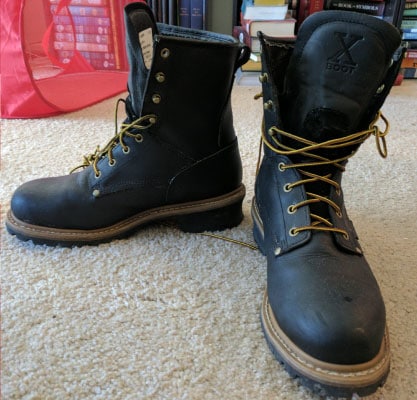
Before we head straight into answering the question, “are logger boots good for concrete?” let’s look at what logger boots really stand for. These boots come with a specific design to tackle everyday stress and a variety of outdoor conditions, especially when someone wears them all day long. For that, most companies who build logger boots keep a strict policy of quality control and building process.
Let’s look at the various components of a pair of logger boots.
· Heels
All logger boots are built with a significantly high heel just to ensure the best traction possible while working outdoors. The high heel provides traction and keeps you from falling whenever you’re working at a height.
· Laced up
Laces are important components when it comes to ensuring a nice, snug fit. These laces are durable, so they prevent tears and keep your boots tightly wrapped around your feet and ankles. Most boots come with an 8-inch of height.
· Welt-construction
This method is useful for better support, and it is also removable when your boots need a repair. A strip of heavy-duty leather is stitched to the bottom edge of the boots.
· Waterproof construction
One of the defining features of these boots is their waterproofing ability. The waterproof membrane is there to protect your boots when you’re working in the rain or accidentally put your feet in puddles. Keeping your feet dry is their motto.
· Steel shanks
Another useful part of the construction is the installation of steel strips or shanks. They sit between the insole and the outsole and provide durability and ruggedness and save your feet from punctures and outsole deformities. However, they add to the weight and stiffness of the sole.
· Tough leather
Leather can be sensitive to hot and humid conditions and rain and snow. That’s why all logger boots require the best quality, heavy-duty leather for construction. They protect your feet from mud, rain, snow, and hot surfaces.
· Steel toes
While you work in factories and around lumber, it is necessary to ensure that your feet don’t hurt from falling objects. So, these boots often come with protective steel toe caps to safeguard your upper feet and toes.
These components make logger boots one of the toughest boots possible.
Are logger boots good for concrete?
Now, let’s get back to the main question, are logger boots good for concrete?
Logger boots have different protective features like safety toes, raised heels, waterproof leather, and outsoles with lug patterns. Due to these attributes, workers can prevent injuries to their feet. However, the problem is that they are weighty and stiff. Industrial workers who need to walk regularly on bumpy concrete surfaces can put on these shoes. Moreover, linemen and demolition workers may try out these boots.
However, concrete surfaces can also be of several types, and some of them are very rough. If there are too many bumps and chips on the surface, then it is a good idea to keep your logger boots on to avoid any discomfort and foot injury.
On the other hand, if the concrete surface is smooth, then it might not be a great idea to wear these boots. The reason is logger boots come with so many protective layers and high-quality material, which also adds to the weight and stiffness.
So, regular work boots perform just fine on these surfaces. Bringing your logger boots on such surfaces might sound like overkill. So, if you work on uneven concrete, only then can you wear your logger boots. Otherwise, regular work boots are the option to go for.
Frequently Asked Questions For Are Logger Boots Good For Concrete?
Are Logger Boots Good For Working On Concrete?
Logger boots are ideal for working on concrete as they offer the necessary support and padding to your feet and ankles. These boots are designed to provide safety and comfort to workers who spend extended periods standing on hard surfaces.
What Is The Best Type Of Sole For Working On Concrete?
Outsoles with slip-resistant features are best for working on concrete. Look for soles that provide adequate grip and traction, which reduce the risk of slip and fall injuries. Many modern work boots are equipped with slip-resistant soles, but it’s important to choose a pair that suits your work environment.
How Do Logger Boots Protect Your Feet On Concrete?
Logger boots are designed with high-quality materials that provide the necessary protection and support to your feet and ankles. They have a thick rubber sole that cushions your feet against the hard surface of concrete, and therefore help to prevent foot fatigue and joint pain during long workdays.
Do Logger Boots Help Prevent Slips And Falls On Concrete?
Logger boots are often designed with features that reduce the risk of slips and falls on concrete surfaces. They come equipped with slip-resistant soles that provide superior traction, which is especially important when working on wet or oily surfaces.
Can Logger Boots Be Worn On Any Other Surfaces Apart From Concrete?
Yes, logger boots are versatile and can be worn on surfaces such as gravel, mud, and other rugged terrain. These boots offer versatility and durability, and are ideal for workers who require safety, comfort, and mobility when working in challenging environments.
Conclusion
Logger boots are an excellent choice for working on concrete surfaces. They provide enhanced protection, support, and comfort without compromising mobility. The thick outsoles cushion the feet and joints, reducing the risk of injuries from slippage, impact, or fatigue. The steel-toed design shields the toes from falling objects and compression, while the waterproof and breathable materials keep the feet dry and fresh.
Additionally, they offer ample arch support, stability, and shock absorption, making it easier to work for longer periods without discomfort. However, it is essential to choose a high-quality pair that fits correctly and meets safety standards. Proper maintenance, such as cleaning, drying, and lubricating, can extend the life of your boots and maintain their performance.
Overall, if you spend a lot of time working on hard surfaces like concrete, investing in a pair of logger boots can be a wise decision for your feet, safety, and productivity.

